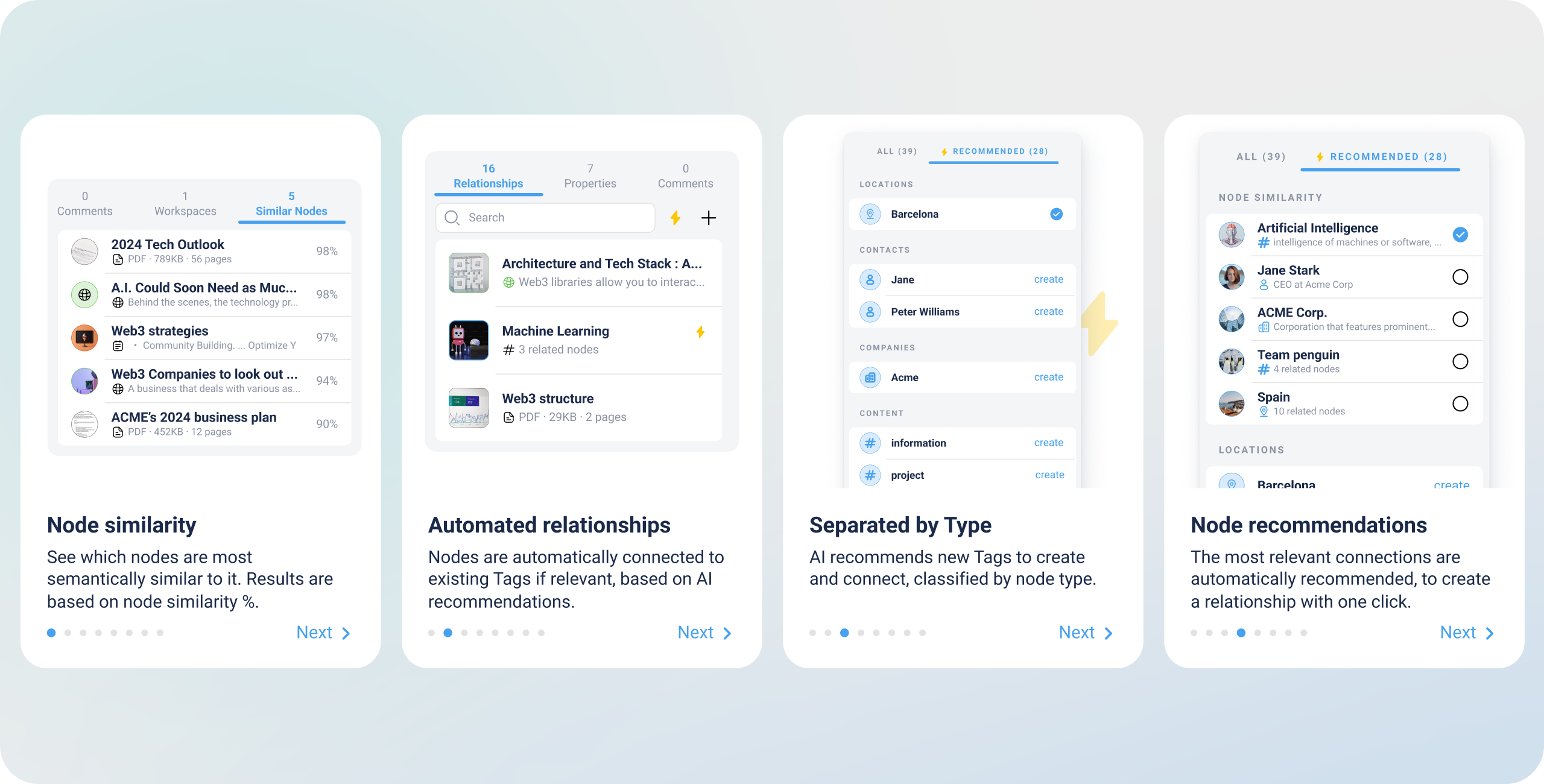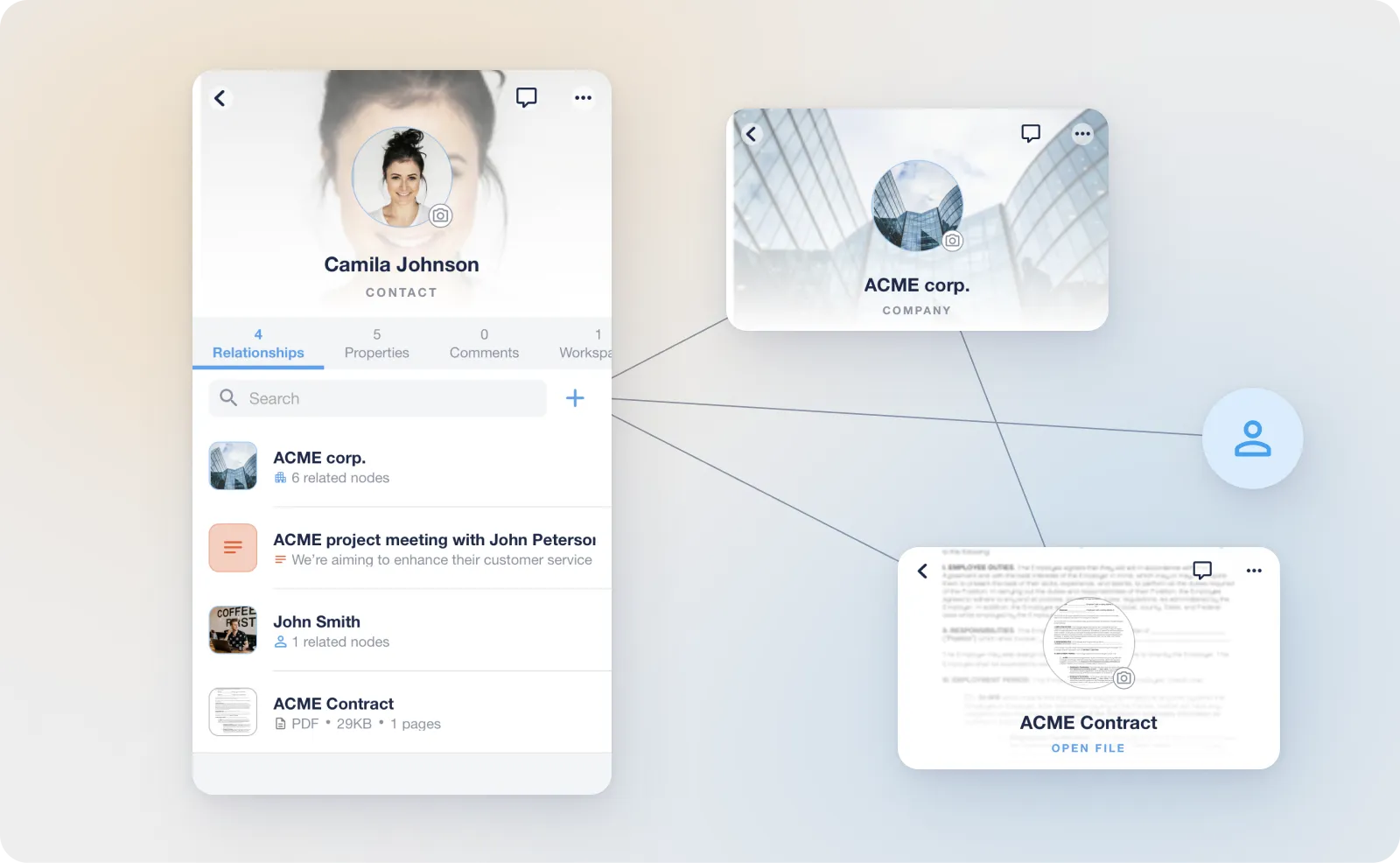Relationships
What are Relationships?
A Relationship is a connection between two Nodes, which allows you to link and explore related data in myReach. 🔗
Adding a Relationship between nodes
There are several ways to create a relationship between items:
Using the existing list of nodes
In the relationship tab of any node, click the "+" button to see a list of all the nodes. A relationship can be created to any of these nodes.
Nodes that already have a relationship to the current node have a grey checkmark. You can click on them to remove the relationship, indicated by a red cross. You then have to click “Done” on the bottom of the screen.
To add new relationships, select nodes from the list, and a blue checkmark will appear. Once you've selected all the desired nodes, click "Done" to create these new connections.
Using the Recommended list
Recommendations are AI-driven suggestions provided to enhance your knowledge management and connections within the platform.
Recommendations aim to help you automatically create connections based on content similarity.
Data is most useful when connected to other relevant things. It becomes easier to search and grows your network of knowledge.
In myReach, adding a relationship manually is an option, but it’s time-consuming and not as effective. The best is to create relationships recommended by AI.
Here’s how it works:
Automatic Relationships: The ⚡ next to any relationship in a node indicates it was generated automatically (ex: save an article about criminal law and it will automatically connect it to the Tag you already had called Law).
For new Tag recommendations based on AI, click on the ⚡ next to the search bar. It opens up the list of recommendations. There are four things here:
1️⃣ Node Similarity: our AI algorithm detects all the nodes with a high % similarity using vector embedding. From these, it extracts all the Tag-based relationships and recommends them here.
2️⃣ Tags (locations, contacts, companies): myReach detects and recommends a list of potential Tags, with a one-click button to “create” the Tag and automatically add a relationship to the current node. This saves you time from having to manually create Tags.
3️⃣ Identified objects: For images, the AI provides recommendations for identified objects, useful for grouping similar concepts.
For example, it could identify objects in an image related to interior design.
4️⃣ Extracted URLs: If there are URLs in the text, myReach detects and recommends them as new relationships. A new node is created with a link to connect the two pieces of information.
These recommendations significantly reduce manual efforts in finding and connecting related data, streamlining your knowledge-building process.
How to add a relationship using recommendations
Click on “Create” for any Tag recommendations you want to create, and then “Done” at the bottom of the page.
A relationship is added and a new node will be created in the current workspace, displayed under the list of relationships of the current node.
By Searching
When you’re in the relationships tab of any node, after clicking the “+” button, start typing a word in the search bar (ex: “Report”). myReach will show results that match your query in titles, descriptions, comments and content of existing nodes. If the searched node doesn’t exist, you have the option to:
-
Expand your search across all workspaces, by clicking “Search in all Workspaces”.
-
Create it as a new Topic (Tag), with an automatic relationship to the current node.
Once you’re done making your connections, click “Done” to add the relationships.
When you create a topic node on the fly, myReach automatically searches Wikipedia for information related to that concept. It adds the Wikipedia description, a picture (if available), and a direct link to the corresponding Wikipedia page. You have the option to click on the link to access the Wikipedia page directly.
If you ever need to edit the Wikipedia link, description, or image, you can do so by clicking on the topic node and making the necessary changes.
By Uploading one or more items
When you click the “+” button to add a relationship, there is an option to “Upload one or more items”. When you click it, a pop-up window appears, enabling you to select and upload files directly. You can pick one or several files, including images, from your device. Once you're done selecting the files, click "Done." myReach will then process and upload them.
If you upload multiple images, myReach will group them into an album node. If you upload various types of files, such as documents or contacts, it will create individual nodes for each.
All these newly created nodes will automatically be linked by a relationship to the currently selected topic or node.
Each relation is represented in the relationship tab, with nodes coloured differently depending on their originating workspace. Nodes appearing in colour are from the same workspace as the current node while those in grey belong to other workspaces. This distinction helps you identify where each node is saved.
You can click on any of the connected nodes to navigate to them and perform searches related to them. For instance, if you search for specific keywords, myReach will provide search results from the title, description, and content of nodes.
Shortcuts
There are certain shortcuts and actions you can perform in the relationships section:
Removing Relationships: Swipe left to remove a relationship.
Opening Websites: For website nodes, you can swipe left and click "Open" to directly open the linked website in a new tab.
Naming the Relationships: Swipe right to give a name to a relationship between two nodes. This can help clarify why the nodes are connected, providing context for your data. This is an advanced feature but can be valuable for understanding relationships.
-
between two people: “brother”, “friend”, “colleague”, “competitor”
-
Remember who sent it to you: “recommended by”
-
Make note of who you went with: “been with”, “attended”
This way it’s easier to remember why you saved something, and what’s the connection between the two things. It’s future-proofing to make sure things make sense to you down the road.

